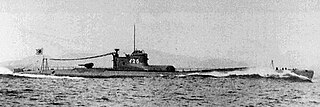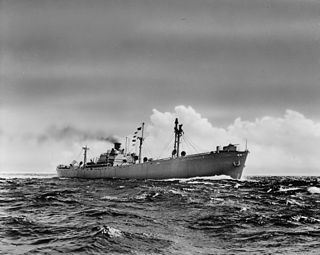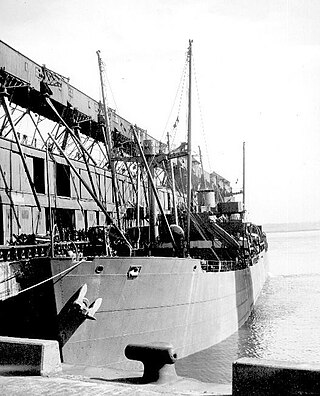
USS Vesole (DD-878) was a Gearing-class destroyer of the United States Navy.

I-26 was an Imperial Japanese Navy B1 type submarine commissioned in 1941. She saw service in the Pacific War theatre of World War II, patrolling off the West Coast of Canada and the United States, the east coast of Australia, and Fiji and in the Indian Ocean and taking part in Operation K, preparatory operations for the Aleutian Islands campaign, and the Guadalcanal campaign, the Marianas campaign, and the Battle of Leyte Gulf. She was the first Japanese submarine to sink an American merchant ship in the war, sank the first ship lost off the coast of State of Washington during the war, damaged the aircraft carrier USS Saratoga (CV-3), sank the light cruiser USS Juneau (CLAA-52), and was the third-highest-scoring Japanese submarine of World War II in terms of shipping tonnage sunk. Her bombardment of Vancouver Island in 1942 was the first foreign attack on Canadian soil since 1870. In 1944, I-26′s crew committed war crimes in attacking the survivors of a ship she sank. She was sunk in October 1944 during her ninth war patrol.

Inhambane[iɲɐ̃ˈbani], also known as Terra de Boa Gente, is a city located in southern Mozambique, lying on Inhambane Bay, 470 km northeast of Maputo. It is the capital of the Inhambane Province and according to the 2017 census has a population of 79,724, growing from the 1997 census of 54,157.

SS Samuel Huntington was an American liberty ship during World War II. She was the 248th liberty ship authorized by the United States Maritime Commission and was named in honor of Samuel Huntington, a Founding Father and signer of the American Declaration of Independence. SS Samuel Huntington was launched in 1942 and sailed to ports in the Pacific, South America, Africa, and the United Kingdom. She was one of a select group of liberty ships that were outfitted to carry a limited number of either troops or prisoners of war. As part of a convoy to resupply the Allied troops at Anzio, she sank after a successful German bomb attack in January 1944.
German submarine U-178 was a Type IXD2 U-boat of Nazi Germany's Kriegsmarine built for service during World War II.
German submarine U-177 was a Type IXD2 U-boat of Nazi Germany's Kriegsmarine during World War II. The submarine was laid down on 25 November 1940, at the DeSchiMAG AG Weser yard in Bremen, as yard number 1017. She was launched on 1 October 1941, and commissioned on 14 March 1942, under the command of Kapitänleutnant Wilhelm Schulze. After a period of training with the 4th U-boat Flotilla at Stettin, the boat was transferred to the 10th flotilla on 1 October 1942, and based at Lorient, for front-line service, she was then reassigned to the 12th flotilla at Bordeaux on 1 December.
Empire City was a 7,295 GRT cargo ship which was built in 1943 by William Doxford & Sons Ltd, Sunderland for the Ministry of War Transport (MoWT). She was torpedoed and sunk on 6 August 1944 by U-198.

I-10 was an Imperial Japanese Navy Type A1 submarine that served during World War II. Designed as a submarine aircraft carrier, she was commissioned in 1941 and supported the attack on Pearl Harbor, operated in the Indian Ocean — including support for the 1942 midget submarine attack on Diego Suarez — and in the New Caledonia and New Zealand areas, and took part in the Guadalcanal campaign and Marianas campaign before she was sunk in 1944 during her seventh war patrol.
Arietta was a 7,460 GRT cargo ship that was built in 1941 as Empire Cranmer by J L Thompson & Sons Ltd, Sunderland, Co Durham, United Kingdom. She was built for the Ministry of War Transport (MoWT). Empire Cranmer was transferred to the Greek Government in 1942 and renamed Thraki. In 1947, she was sold into merchant service and renamed Arietta. On 17 March 1960, she ran aground at Novorossiysk, Soviet Union. Although refloated on 1 April, she was declared a constructive total loss.
Empire Cromwell was a 5,970 GRT cargo ship that was built in 1941 by William Pickersgill & Sons Ltd, Sunderland, Co Durham, United Kingdom for the Ministry of War Transport (MoWT). She was torpedoed and sunk off Trinidad on 28 November 1942 by U-508.
Empire Day was a 7,241 GRT cargo ship that was built in 1941 as a CAM ship by William Doxford & Sons Ltd, Sunderland, Co Durham, United Kingdom for the Ministry of War Transport (MoWT). In 1943, she was converted to a standard cargo ship. She served until August 1944 when she was torpedoed and sunk by U-198.
Empire Driver was a 7,042 GRT cargo ship that was built in 1942 by William Gray & Co Ltd, West Hartlepool, Co Durham, United Kingdom for the Ministry of War Transport (MoWT). In 1945, she was transferred to the French Government and renamed Radiotélégraphiste Biard. She was sold to an Italian company in 1950 and renamed Dea Mazzella. In 1956, she was renamed Maria Mazzella. Further sales in 1960 and 1964 saw her renamed Falzarego and Grazia Prima respectively. In 1965, she was sold to Liberia and renamed Missouri. She served until 1969 when she was scrapped.

SS Marcus Daly was a liberty ship built by the Kaiser Shipyards at their Permanente No.1 yard at Richmond, California, and launched on 24 July 1943.
SS Dalfram (1930-1943) was a British Cargo Steamer of 4,558 tons built in 1930 by Scotts Shipbuilding and Engineering Company, Greenock for Campbell Brothers and Co, Newcastle upon Tyne. The ship was launched on 2 April 1930.
I-37, originally numbered I-49, was a Japanese Type B1 submarine in service with the Imperial Japanese Navy during World War II. Commissioned in 1943, she made three war patrols, all in the Indian Ocean, during the last of which her crew committed war crimes by massacring the survivors of the merchant ships she sank. Subsequently, converted into a kaiten manned suicide attack torpedo carrier, she was sunk during her first kaiten mission in 1944.

SS Jasper Park was a Park ship freighter, built in 1942. She was sunk by torpedo from German submarine U-177 on 6 July 1943, the first Park ship lost to enemy action. She was completed on 24 September 1942, by the company Davie Shipbuilding in Lauzon, Quebec. Her hull number is 537. Davie Shipbuilding is now called Chantier Davie Canada Inc. The ship was owned by the Park Steamship Company, which was owned by Canada's Federal government. The government had built 400 vessels during World War II. Built as a merchant steamship constructed for Canada’s Merchant Navy in 1942. She was named after Jasper National Park in the Canadian Rockies in the province of Alberta, Canada.

SS Albert Gallatin was an American Liberty ship that operated during World War II. She was named for Albert Gallatin (1761–1849), an American politician, diplomat, ethnologist, and linguist who served as the United States Secretary of the Treasury from 1801 to 1814. She was sunk by the Imperial Japanese Navy submarine I-26 in the Arabian Sea in 1944.

SS Anne Hutchinson was a Liberty ship built by the Oregon Shipbuilding Company of Portland, Oregon, and launched on 31 May 1942 The ship was named after the Anne Hutchinson, a 1600 Massachusetts Bay Colony Puritan.

SS Benjamin Contee was an American Liberty Ship type EC2-S-C1 built in 1942 by the Delta Shipbuilding in New Orleans, Louisiana as part of the Emergency Shipbuilding Program for World War II. She was laid down on February 2, 1942, launched on June 15, 1942, and completed on August 7, 1942. She was operated by the Mississippi Shipping Company for the War Shipping Administration as a United States Merchant Marine ship. She was a Maritime Commission design. Like other Liberty ships, she was 441 feet (134 m) long and 56 feet (17 m) wide, carried 9000 tons of cargo and had a top speed of 11 knots (20 km/h). Most Liberty ships were named after prominent deceased Americans. She was converted from a cargo ship to a troop transport ship. She is named after Benjamin Contee, an American Episcopal priest and statesman from Maryland. He was an officer in the American Revolutionary War, a delegate to the Confederation Congress, and a member of the first United States House of Representatives.
Seas Shipping Company, owner of the Robin Line was founded in 1920 in New York City, New York. The Robin Line named all its ships starting with the word Robin. Robin Line was intercoastal fleet started as the predecessor of the Farrell Lines founded in 1948. James A. Farrell, Jr., and John J. Farrell, sons of James Augustine Farrell, president of US Steel founded the Robin Line. Robin Line had two major stock holders the Lewis family and the Farrell family. In 1933, the two families ended their partnership and became rivals. The Robin line entered the Africa trade routes, competing against the Farrell Line. The two companies remained rivals until the death of Arthur W. Lewis, Jr. in 1954. Robin Line was sold to Moore-McCormack Lines in 1957.








